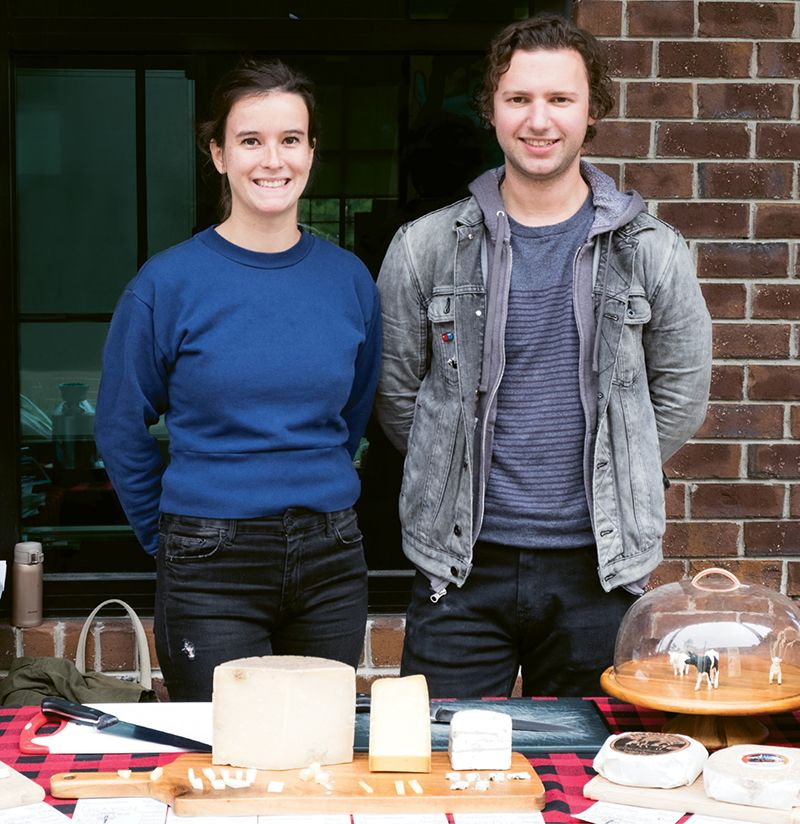Chatting with the couple behind three-year-old purveyor Counter Cheese Caves, the new ambassadors for Southeastern cheese

Find Counter Cheese Caves every Saturday at Pacific Box & Crate Farmers Market and John’s Island Farmers Market
CM: You two are married. How did you get together and decide you wanted to work in cheese?
NG: Actually, we met at a cheese shop.
EC: Murray’s Cheese in Manhattan—it’s a New York cheese institution, and a great place to learn the industry. I focused on cave-aging; it’s one of the only creative aspects of the cheese world.
CM: How is cave-aging creative?
EC: You can taste through batches of one specific cheese and decide whether one is ready to be sold now, or if one could use a couple more months. It has a lot of parallels to the wine world.
CM: Why open shop in Charleston?
EC: The Southeast is the final frontier of US cheesemaking.
NG: The West Coast, the Northeast, and Midwest are all established. Now, there are a lot of cheesemakers in this region, and it’s really coming into its own.
CM: What is it you’re looking for from cheesemakers?
NG: We’re always looking out for specific styles, like non-cow’s milk cheeses, since sheep and goat’s milk cheeses are somewhat rare. Or unique cheeses, like one we just brought in from the Atlanta area: the “Banjo” from Hobo Cheese Co.
EC: That’s a fresh, Italian-style cow’s milk cheese, modeled after stracchino. We try to showcase cheeses we think are underrepresented, or styles we don’t already have in our lineup.
CM: Are most of the cheesemakers you represent also farmers?
NG: It’s about half and half. Some are farmstead operations, so cheesemaking is done on the same land where the animals are raised. But you can also source milk to make cheese.
EC: Even if cheesemakers are sourcing their milk, it’s usually from a neighboring dairy, or someone they have a very close relationship with and know the milk quality.
CM: How are American cheesemakers influenced by European traditions?
EC: Europe is the cheese mainland, and everyone is getting their inspiration from European cheeses, sometimes along with some information and guidance from makers.
NG: Everything in cheese has a history or a reason it’s done a certain way—just like wine.
EC: For instance, a layer of vegetable ash through the middle of cheese is a nod to separating morning and night milking. It protected the cheese from flies and stuff getting in there between milkings. Now, the ash is just a nod to tradition.
CM: What is your goal with Counter Cheese Caves?
EC: Supporting smaller Southeastern cheesemakers. We’re facilitating moving their cheese while also trying to educate the food industry and public. In general, people are a little intimidated about cheese and ask questions, like, “Do I eat the rind?”
NG: We’re breaking down that barrier and trying to be approachable.
CM: Any special projects in the works?
NG: We run a cheese share with fun pairing suggestions through our website, for pick-up at Edmund’s Oast Exchange.
EC: We’re meeting with a bride soon to discuss a cheese wheel wedding cake, which is what we had at our wedding.
NG: Our motto is wherever, whenever, however.
EC: Anything that can be done with cheese, we’ll do it.
Photographs by (Xiao Bao Biscuit) Olivia rae James, (Bread Loaf) Courtesy of Tiller Baking Co., & (Beer) Munkle Brewing Co.